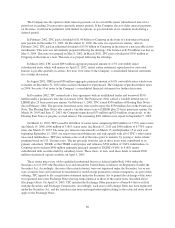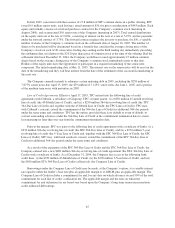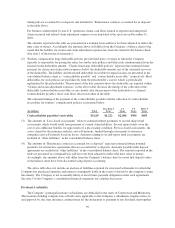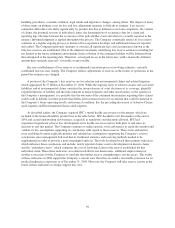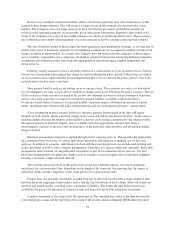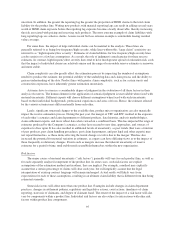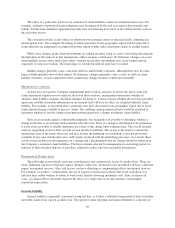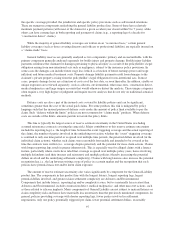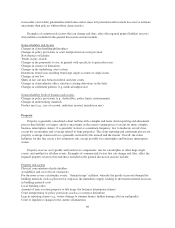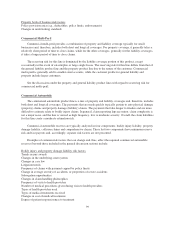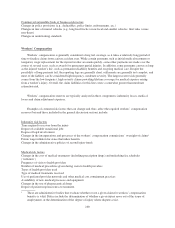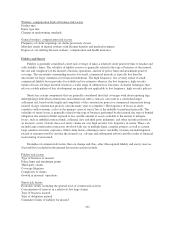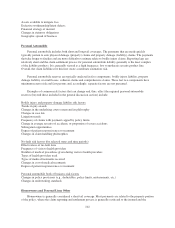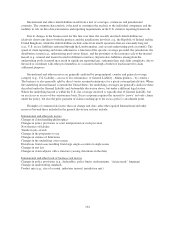Travelers 2004 Annual Report Download - page 108
Download and view the complete annual report
Please find page 108 of the 2004 Travelers annual report below. You can navigate through the pages in the report by either clicking on the pages listed below, or by using the keyword search tool below to find specific information within the annual report.
The effect of a particular risk factor on estimates of claim liabilities cannot be isolated in most cases. For
example, estimates of potential claim settlements may be impacted by the risk associated with potential court
rulings, but the final settlement agreement typically does not delineate how much of the settled amount is due to
this and other factors.
The evaluation of data is also subject to distortion from extreme events or structural shifts, sometimes in
unanticipated ways. For example, the timing of claims payments in one geographic region will be impacted if
claim adjusters are temporarily reassigned from that region to help settle catastrophe claims in another region.
While some changes in the claim environment are sudden in nature (such as a new court ruling affecting the
interpretation of all contracts in that jurisdiction), others are more evolutionary. Evolutionary changes can occur
when multiple factors affect final claim values, with the uncertainty surrounding each factor being resolved
separately, in step-wise fashion. The final impact is not known until all steps have occurred.
Sudden changes generally cause a one-time shift in claim liability estimates, although there may be some
lag in reliable quantification of their impact. Evolutionary changes generally cause a series of shifts in claim
liability estimates, as each component of the evolutionary change becomes evident and estimable.
Management’s estimates
At least once per quarter, Company management meets with its actuaries to review the latest claim and
claim adjustment expense reserve analyses. Based on these analyses, management determines whether its
ultimate claim liability estimates should be changed. In doing so, it must evaluate whether the new data provided
represents credible actionable information or an anomaly that will have no effect on estimated ultimate claim
liability. For example, as described above, payments may have decreased in one geographic region due to fewer
claim adjusters being available to process claims. The resulting claim payment patterns would be analyzed to
determine whether or not the change in payment pattern represents a change in ultimate claim liability.
Such an assessment requires considerable judgment. It is frequently not possible to determine whether a
change in the data is an anomaly until sometime after the event. Even if a change is determined to be permanent,
it is not always possible to reliably determine the extent of the change until sometime later. The overall detailed
analyses supporting such an effort can take several months to perform. This is due to the need to evaluate the
underlying cause of the trends observed, and may include the gathering or assembling of data not previously
available. It may also include interviews with experts involved with the underlying processes. As a result, there
can be a time lag between the emergence of a change and a determination that the change should be reflected in
the Company’s estimated claim liabilities. The final estimate selected by management in a reporting period is a
function of these detailed analyses of past data, adjusted to reflect any new actionable information.
Discussion of Product Lines
The following section details reserving considerations and common risk factors by product line. There are
many additional risk factors that may impact ultimate claim costs. Each risk factor presented will have a different
impact on required reserves. Also, risk factors can have offsetting or compounding effects on required reserves.
For example, in workers’ compensation, the use of expensive medical procedures that result in medical cost
inflation may enable workers to return to work faster, thereby lowering indemnity costs. Thus, in almost all
cases, it is impossible to discretely measure the effect of a single risk factor and construct a meaningful
sensitivity expectation.
General Liability
General liability is generally considered a long tail line, as it takes a relatively long period of time to finalize
and settle claims from a given accident year. The speed of claim reporting and claim settlement is a function of
96


